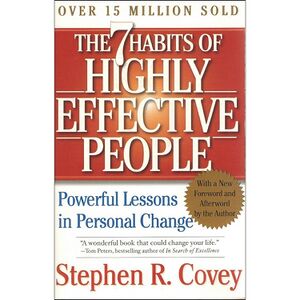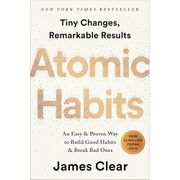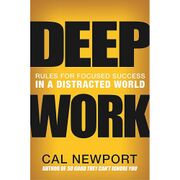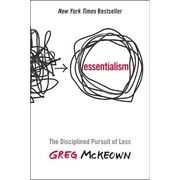The 7 Habits of Highly Effective People
🍎 Healthy brain food
"Synergy is better than my way or your way. It’s our way."
— Stephen R. Covey, The 7 Habits of Highly Effective People (1989)
Introduction
| The 7 Habits of Highly Effective People | |
|---|---|
 | |
| Full title | The 7 Habits of Highly Effective People: Restoring the Character Ethic |
| Author | Stephen R. Covey |
| Language | English |
| Subject | Personal development; Leadership; Self-help |
| Genre | Nonfiction; Self-help |
| Publisher | Simon & Schuster |
Publication date | 1989 |
| Publication place | United States |
| Media type | Print (hardcover, paperback); e-book; audiobook |
| Pages | 340 |
| ISBN | 978-0-671-66398-8 |
| Goodreads rating | 4.2/5 (as of 6 November 2025) |
| Website | simonandschuster.com |
📘 The 7 Habits of Highly Effective People presents Stephen R. Covey’s principle-centered, inside-out model for personal and professional effectiveness.[1] It opens with paradigms and principles, groups the seven habits into “Private Victory” (Habits 1–3), “Public Victory” (4–6), and “Renewal” (7), and closes by returning to the inside-out theme.[2] Covey writes in an instructional, anecdote-rich register, illustrating habits such as Be Proactive, Begin with the End in Mind, and “Seek First to Understand, Then to Be Understood.”[1] The publisher reports New York Times bestseller status and more than 40 million copies sold worldwide.[1] By 1994 it had logged 220 weeks on the Times list and 250 weeks by 1996; the audiobook surpassed 1.7 million copies by 2005.[3][4][5]
Chapter summary
This outline follows the Simon & Schuster hardcover edition (1989, ISBN 978-0-671-66398-8).[2][6]
I – Paradigms and Principles
🧭 1 – Inside-Out. At Harvard Business School, a professor primed half the class with a picture of a young woman and the other half with an old woman, then projected a composite image; after just 10 seconds of conditioning, each group “saw” its version and argued until one student pointed to a “necklace” that another insisted was a “mouth,” and only then did both perspectives come into focus. The demonstration shows how frames shape perception and behavior. While teaching leadership at IBM, the gap between quick-fix techniques and deeper principles became undeniable, and it contrasts the post–World War I “Personality Ethic” with the older “Character Ethic.” A family vignette makes it concrete: after cheering, coaching, and protecting their son—who cried that he didn’t like baseball—the parents stepped back, examined their motives, and began to see him as fundamentally capable. As they stopped comparing and manipulating, he developed confidence and, over time, excelled academically, socially, and athletically, even earning all-state honors and student leadership roles. A map metaphor drives the point home: the wrong paradigm is like using a Detroit map to navigate Chicago—you can try harder or be nicer and still end up lost. Meaningful change starts with private, character-level work rather than external image management. Shifting the paradigm—how we see—alters what we do and the results we get, aligning behavior with timeless principles. By working from the inside out, private victories create the foundation for public victories and durable relationships. The way we see the problem is the problem.[7]
🧩 2 – The Seven Habits – An Overview. The overview anchors effectiveness in Aesop’s “Goose and the Golden Egg”: production (golden eggs) must be balanced with production capability (the goose), illustrated with everyday examples like asking a daughter to keep her room clean—results matter, but so does the relationship that makes those results sustainable. Effectiveness is defined by that balance (P/PC), not by short-term wins that damage the asset that produces them. A habit is the intersection of knowledge (what and why), skill (how), and desire (want to), and only when all three overlap does behavior become reliable. Growth follows a Maturity Continuum from dependence (“you”) to independence (“I”) to interdependence (“we”), and the habits are sequenced to match natural development. Habits 1–3 build the Private Victory of self-mastery; Habits 4–6 create the Public Victory of effective interdependence; Habit 7 renews the capacity to live all the others. Principles, not personality tactics, generate compounding returns when aligned with systems and relationships. Seen this way, change is sequential and reinforcing: small, principle-centered practices upgrade capability, which improves results, which deepens commitment. The book presents the habits as an integrated, upward spiral rather than isolated tips. The P/PC Balance is the very essence of effectiveness.[7]
II – Private Victory
🚀 3 – Habit 1: Be Proactive. Viktor Frankl, a Viennese psychiatrist imprisoned in Nazi concentration camps during World War II, observed that even under brutal conditions there remained a gap between what happened and how he chose to respond; that inner freedom anchors proactivity. Proactivity means taking responsibility for one’s decisions rather than being driven by moods, weather, or other people. A quick diagnostic is language: choosing words that reflect agency (I choose, I will) instead of resignation (I can’t, they won’t). Two concentric diagrams clarify attention—an outer Circle of Concern (things we care about) and an inner Circle of Influence (things we can affect). Energy invested in the inner circle expands it; energy spent on the outer circle shrinks what we can actually change. Problems sort into three classes—direct (our behavior), indirect (others’ behavior), and no control (past events or fixed realities)—which call for self-change, influence skills, or genuine acceptance. Proactivity also shows up as keeping commitments, honoring appointments, and initiating solutions instead of blaming conditions. By focusing attention on controllables, identity and outcomes shift together; attention works like an investment that compounds into capability. Repeated choices in that stimulus–response space build self-efficacy, widening influence and strengthening character. Proactive people focus their efforts in the Circle of Influence.[7]
🎯 4 – Habit 2: Begin with the End in Mind. A visualization exercise places you at your own funeral as four speakers—a family member, a friend, a work associate, and someone from a community or church group—offer tributes about your life. Writing the words you hope to hear clarifies the destination that should govern today’s decisions. From there follows the principle of two creations: every result is made first in the mind and then in reality, like drafting a blueprint before a house is built. Personal leadership ensures the first creation is yours—anchored in principles rather than other people’s agendas. A personal mission statement captures that direction in plain language and serves as a daily compass. Roles such as parent, professional, friend, and citizen, paired with long-term goals, keep effort balanced. Imagination pictures the preferred future; conscience tests that vision against what is right; independent will commits to it despite pressure. When order flows from purpose, planning and action align, and even small tasks take on meaning. Clarity at the end simplifies choices in the middle, creating a chain in which identity drives priorities and priorities drive behavior. All things are created twice.[7]
📅 5 – Habit 3: Put First Things First. A home vignette shows stewardship delegation in practice: a father and son negotiate responsibility for the family lawn and agree to a simple standard—green and clean—with help available as a resource and regular check-ins for accountability. Ownership is the point: the son chooses methods while results and review dates are mutually understood. The focus then shifts to priority and time, contrasting gofer control with stewardship agreements that specify desired results, guidelines, resources, accountability, and consequences. To allocate effort wisely, the Time Management Matrix sorts work by urgency and importance into four quadrants. Quadrant II contains prevention, relationship building, planning, preparation, and real recreation, while Quadrant I holds crises and pressing deadlines. Quadrants III and IV pull attention into interruptions and trivia that feel busy but do not matter. Weekly planning around roles and goals protects Quadrant II, while daily adapting keeps commitments realistic. Effectiveness rises when important-but-not-urgent work gets prime time and when results are entrusted through clear agreements rather than micromanaged. That shift converts calendar space into capability: fewer fires, stronger relationships, and more consistent results. Quadrant II is the heart of effective personal management.[7]
III – Public Victory
🤝 6 – Habit 4: Think Win/Win. In a quiet conference room, two counterparts open a yellow legal pad and write a single heading across the top: Win/Win or No Deal, a signal that either both benefit or both walk away. They sketch a stewardship agreement that captures five concrete elements—desired results, guidelines, resources, accountability, and consequences—so expectations are explicit before any work starts. The discussion names the six paradigms of human interaction (Win/Win, Win/Lose, Lose/Win, Lose/Lose, Win, and Win/Win or No Deal) and rejects the scarcity mentality that pits one side against the other. Instead, they test for the balance of courage and consideration that marks maturity, and they mind the “Emotional Bank Account,” recognizing that trust—not technique—makes agreements stick. Systems have to support the intent, so they ask whether hiring, compensation, and measurement reward cooperation or accidentally pay for internal competition. When they hit a snag, they use a simple process: look from the other person’s point of view, surface key concerns, agree on results that would satisfy both, then invent new options to reach those results. The tone stays principled rather than positional; they refuse cheap compromises that mortgage the relationship for a quick win. By the end, the paper shows outcomes both can own, review dates, and clear space for either side to say “no deal” without blame. Seen this way, effectiveness is negotiated around mutual benefit rather than traded as concessions. Win/Win works because character (integrity, maturity, an abundance mentality) creates trust, which enables agreements, which in turn are reinforced by aligned systems and a repeatable process that turns conflict into collaboration.[7]
👂 7 – Habit 5: Seek First to Understand, Then to Be Understood. Imagine walking into an optometrist’s office with blurred vision and, before any exam, being handed the doctor’s own glasses with the assurance that they work great—an instant prescription without a diagnosis. The mismatch is obvious, yet that is how most conversations go: we prescribe our advice before we understand another person’s view. Five levels of listening—ignoring, pretending, selective, attentive, and empathic—show how “autobiographical responses” (evaluating, probing, advising, interpreting) distort what we hear. Empathic listening slows the exchange to reflect both content and feeling until the speaker feels seen and safe; only then does clear expression land. The same discipline—diagnose before you prescribe—guides interviews, sales calls, performance reviews, and parenting conversations. When it is time to be understood, the task is to state ideas with courage and clarity while anchoring them to the other person’s concerns surfaced through listening. This sequence reduces defensiveness and turns problem solving into joint exploration rather than debate. It also expands influence because people trust what they help to shape. Understanding first changes the emotional climate; meaning replaces noise, and remedies fit because they are tailored, not recycled. Seek first to understand, then to be understood.[7]
🔗 8 – Habit 6: Synergize. Around a table, two groups with competing plans drop the tug-of-war over “my way” and “your way” and go hunting for a third alternative—an outcome neither proposed at the start. Synergy begins with differences: divergent styles, expertise, and assumptions become assets rather than obstacles when the aim is creative cooperation. Communication moves through three levels—defensive (low trust), respectful (polite but limited), and synergistic (high trust, high cooperation)—and only the third reliably produces breakthroughs. In practice, people restate one another’s concerns, add data the other side lacks, and start to combine constraints into design features instead of trade-offs. The math becomes nonlinear—1 + 1 = 3—because insights interact; what emerges is better than the best original proposal. High trust is the catalyst: it invites candid disclosure, risk-taking, and the humility to be influenced. Principles from Habits 4 and 5 power the process—mutual benefit as the aim and empathic listening as the method—so synergy is not accidental; it is engineered. Compromise settles for the midpoint; synergy discovers a new point. Value differences, keep the goal shared, and let respectful collision produce something neither side could have designed alone. Synergy is better than my way or your way. It’s our way.[7]
IV – Renewal
🪚 9 – Habit 7: Sharpen the Saw. In the woods, a man works feverishly to fell a tree; when urged to rest and sharpen his saw, he replies that after more than five hours he is “too busy sawing.” The image sets up Habit 7 as the practice that surrounds and enables the other habits. Here renewal is “personal PC,” defined as steady investment in four dimensions—physical, spiritual, mental, and social/emotional. Treated as Quadrant II work, sharpening the saw expands capability before emergencies force it. Physically, the guidance is simple and home-based: exercise for endurance, flexibility, and strength, supported by rest and sound nutrition. Spiritually, renewal comes from sources that align conscience and purpose, such as prayerful meditation, great literature or music, or time in nature. Mentally, reading deeply, keeping a reflective journal, and planning around roles and goals create a “Daily Private Victory,” even one focused hour a day. Socially and emotionally, everyday interactions are the training ground for Habits 4–6, where deposits of trust increase influence. Neglecting any dimension drags the rest down, in people and in organizations, whereas balanced renewal makes them reinforce one another. This is inside-out growth: regular self-maintenance multiplies production capacity, which in turn improves results without fraying character or relationships. It's preserving and enhancing the greatest asset you have -- you.[7]
🔄 10 – Inside-Out Again. A family sabbatical to Laie on the north shore of Oahu becomes a living lab: after early beach runs and sending two children barefoot to school, writing takes place in an isolated office by the cane fields, and a college-library paragraph about “a gap between stimulus and response” hits with the force of an inward revolution. Middays, two adults ride an old red Honda 90 trail cycle with their preschoolers to a quiet beach about 200 yards from the road and spend roughly two hours a day in deep conversation. Two ground rules shape the practice—no probing and stop when it hurts too much—so vulnerability can emerge without pressure. A long-standing quarrel about buying only Frigidaire appliances finally surfaces, and patient listening uncovers its roots in a daughter’s loyalty to her father, a small-businessman whose inventory had once been financed by that brand. With that insight, tone changes; reverence replaces irritation, and even trivial disputes reveal deeper scripts that deserve respect. The couple keeps the ritual for years—on the trail bike, in the car, or by phone—treating frequent, feelings-first talks as “home base.” The loop closes: as trust deepens, Win/Win becomes real, empathic listening becomes natural, and synergy shows up as options neither side could have invented alone. Lasting change grows from rescripting paradigms before techniques, so character work precedes and powers relationship work. The deliberate use of the stimulus-response space exercises uniquely human endowments and turns recurring dialogue into a flywheel of renewal. You can go home again -- if your home is a treasured relationship, a precious companionship.[7]
Background & reception
🖋️ Author & writing. Stephen R. Covey (1932–2012) was a leadership authority and teacher who earned an MBA from Harvard and a doctorate from Brigham Young University, and later co-founded FranklinCovey.[8] The book’s subtitle, “Restoring the Character Ethic,” and its “inside-out” framing signal a principle-centered approach to change.[2][1] It blends didactic guidance with practical anecdotes and tools across seven named habits.[1] Covey later extended this work in follow-ups such as Principle-Centered Leadership (1992) and First Things First (1994).[9][10] The seven-habits framework also became an ongoing FranklinCovey training curriculum.[11]
📈 Commercial reception. Simon & Schuster reports the book as a New York Times bestseller with more than 40 million copies sold.[1] On the Times lists, it had accumulated 220 weeks by 1994 and 250 weeks by 1996.[3][4] The audiobook became an all-time hit; Publishers Weekly reported 1.7 million-plus units as of 2005.[5] The 30th-anniversary edition also charted on Publishers Weekly’s Trade Paper Frontlist in 2020–2021, peaking at No. 14 on 1 March 2021.[12]
👍 Praise. Time included the book among “The 25 Most Influential Business Management Books,” calling it “a tour de force on confidence building.”[13] Citywire’s review described it as “a compelling read… a leadership/management manual.”[14] An Oxford college review emphasized its transformative intent, calling it a book “trying to… profoundly change the way you live.”[15]
👎 Criticism. In 1996, Time quoted Harvard’s Ronald Heifetz arguing that Covey was “packaging common sense as if it were original.”[4] In Management Learning, Darren McCabe highlighted “unintended consequences” when the “effectiveness” message is translated into workplace programs, and Los Angeles Times also noted critics who saw the phenomenon as part of a self-help “cult” that could trivialize complex problems.[16][3]
🌍 Impact & adoption. Reuters reported Covey’s consulting with organizations such as Procter & Gamble and NASA, reflecting corporate uptake.[17] In late 1994, President Bill Clinton invited Covey (among other authors) to Camp David to discuss integrating the habits into the presidency.[18] The framework underpins FranklinCovey’s Leader in Me program, which the organization says is used in thousands of schools across 70+ countries.[19] Simon & Schuster also lists campus adoptions, including Montana State University’s 2008/2009 freshman-reading program.[1] Time reported broad public-sector and Fortune-500 engagement with Covey’s training in the mid-1990s.[4]
Related content & more
YouTube videos
CapSach articles
Enjoyed this page?
📚If this page The 7 Habits of Highly Effective People inspired or helped you today, a small coffee helps us keep creating and sharing more. Your support truly matters.👏
References
- ↑ 1.0 1.1 1.2 1.3 1.4 1.5 1.6 "The 7 Habits of Highly Effective People (30th Anniversary Edition)". Simon & Schuster. Simon & Schuster. Retrieved 6 November 2025.
- ↑ 2.0 2.1 2.2 "Library of Congress catalog record: The seven habits of highly effective people". Library of Congress. Retrieved 6 November 2025.
- ↑ 3.0 3.1 3.2 Kellogg, Carolyn (16 July 2012). "Stephen R. Covey, '7 Habits of Highly Effective People' author, dies". Los Angeles Times. Retrieved 6 November 2025.
- ↑ 4.0 4.1 4.2 4.3 "TIME 25: They Range in Age from 31 to 67". Time. 17 June 1996. Retrieved 6 November 2025.
- ↑ 5.0 5.1 Maughan, Shannon (6 June 2005). "Audio's Best of the Best". Publishers Weekly. Retrieved 6 November 2025.
- ↑ "The seven habits of highly effective people: restoring the character ethic". WorldCat. OCLC. Retrieved 6 November 2025.
- ↑ 7.00 7.01 7.02 7.03 7.04 7.05 7.06 7.07 7.08 7.09 Covey, Stephen R. (1989). The 7 Habits of Highly Effective People: Restoring the Character Ethic. Simon & Schuster. ISBN 978-0-671-66398-8.
- ↑ "Stephen R. Covey". Simon & Schuster. Simon & Schuster. Retrieved 6 November 2025.
- ↑ "Principle-Centered Leadership". Simon & Schuster. Simon & Schuster. Retrieved 6 November 2025.
- ↑ "First Things First". Simon & Schuster. Simon & Schuster. Retrieved 6 November 2025.
- ↑ "The 7 Habits of Highly Effective People®". FranklinCovey. FranklinCovey. Retrieved 6 November 2025.
- ↑ "Publishers Weekly Bestseller Lists — Trade Paper Frontlist (15 February 2021)". Publishers Weekly. 15 February 2021. Retrieved 6 November 2025.
- ↑ Gandel, Stephen (9 August 2011). "The 7 Habits Of Highly Effective People (1989), by Stephen R. Covey". Time. Retrieved 6 November 2025.
- ↑ "Book review: The Seven Habits of Highly Effective People". Citywire. 4 February 2011. Retrieved 6 November 2025.
- ↑ "Book review: The 7 Habits of Highly Effective People". Pembroke College, University of Oxford. Retrieved 6 November 2025.
- ↑ McCabe, Darren (2011). "Opening Pandora's box: The unintended consequences of Stephen Covey's effectiveness movement". Management Learning. 42 (2): 183–197. doi:10.1177/1350507610389682. Retrieved 6 November 2025.
- ↑ "'The 7 Habits of Highly Effective People' author Stephen R. Covey dies". Reuters. 16 July 2012. Retrieved 6 November 2025.
- ↑ "Clinton's informal meetings include a session with Covey". Deseret News. 4 January 1995. Retrieved 6 November 2025.
- ↑ "About FranklinCovey Education – Leader in Me". Leader in Me. FranklinCovey. Retrieved 6 November 2025.






